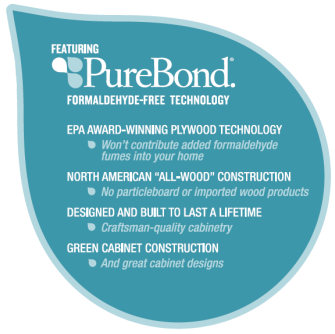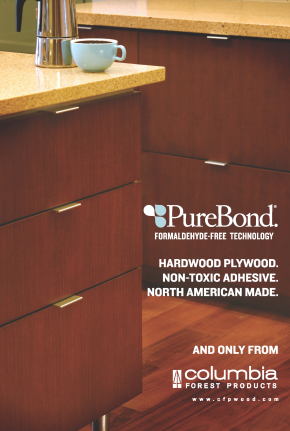OUR MATERIALS
 Against the Grain Woodworking cares about the environment and we work hard to operate green. One of our Eco friendly initiatives has been to incorporate as many green products into our development process as possible.
Against the Grain Woodworking cares about the environment and we work hard to operate green. One of our Eco friendly initiatives has been to incorporate as many green products into our development process as possible.
A wonderful example can be found in our use of EnviroVar™ Formaldehyde Free Acid Cure Conversion Varnish. This product provides an acid-cure formaldehyde free amino-alkyd post-catalyzed conversion varnish that is GREENGUARD Indoor Air Quality Certified®, low-odor and HAPs-free. EnviroVar™ earned a Sequoia New Product Award for Green/Environmental Leadership in Wood Coatings at the AWFS®Fair 2011. The Sequoia New Product Awards recognize creativity and innovation as well as leadership in green/environmental product development in the woodworking industry.
Against the Grain Woodworking JOINS PUREBOND® FABRICATOR NETWORK
Against the Grain Woodworking, Inc., JOINS PUREBOND® FABRICATOR NETWORK, PROVIDING CABINETRY WITH FORMALDEHYDE-FREE TECHNOLOGY FOR BETTER INDOOR AIR QUALITY
Charlotte, North Carolina, April 30th, 2012. Against the Grain Woodworking, Inc., a maker of cabinets, furniture, fixtures and millwork located in Charlotte, NC, announces that it has joined the PureBond® Fabricator Network.
The PureBond® Fabricator Network is a partnership of Columbia Forest Products, Inc. with cabinet and furniture fabricators who share the ability to build quality cabinetry, furniture and fixtures from sustainable wood products made using PureBond® formaldehyde-free technology.
The network is made up of leading fabricators of across the United States and Canada. It serves as a resource for homeowners, builders, remodelers, kitchen dealers, architectural specifiers and commercial project owners who are committed to good indoor air quality, and looking to avoid toxins and VOCs (volatile organic compounds).
Good indoor air quality benefits everyone – especially infants and young children, the elderly, and people suffering from asthma or other respiratory conditions. As part of the PureBond® Fabricator Network, Against the Grain Woodworking, Inc., will educate homeowners and others about the benefits of using formaldehyde-free hardwood plywood technology, and to help them make “healthy choices” when building or remodeling a home or buying products such as cabinetry and furniture.
Urea formaldehyde (UF), which has been widely used in the manufacture of hardwood plywood and composite panels, has been classified by the World Health Organization’s International Agency for Research on Cancer as carcinogenic to humans. UF is commonly found in pressed wood products.
PureBond® technology represents a major breakthrough in formaldehyde-free building products. Developed by Columbia Forest Products in concert with scientific experts at Oregon State University’s College of Forestry, the first PureBond® hardwood plywood panels were shipped in 2005. As of mid-2010, more than 40 million panels had been manufactured for use in making cabinets, furniture and fixtures, at prices that keep breathing easily affordable – Columbia does not charge a premium for its PureBond panels.
Established in 2011, Against the Grain Woodworking, Inc. is a fabricator of cabinets, millwork, furniture and fixtures serving customers in the greater Charlotte area. For more information on products made using PureBond®formaldehyde-free technology, contact Ian Ratcliffe at 704-309-5750.

Against the Grain Woodworking Supports Formaldehyde-free
Formaldehyde is a colorless, strong-smelling gas. It is widely used to manufacture building materials and numerous household products. Its most significant use in homes is as an adhesive resin in pressed wood products.
Building products made with formaldehyde resins emit formaldehyde gas.
Particle board is the base material used in most manufactured kitchen cabinets. The board is usually made of cellulose reconstituted with the use of urea formaldehyde resin, and made into panels that are cut into boards for constructing furniture and building products. Formaldehyde is a recognized carcinogen, and a sensitizer, meaning that exposure to formaldehyde can make a person more sensitive to other chemicals.
Researchers have been working to find a replacement for the urea-formaldehyde-based glues used to make interior wood composite panels including interior plywood, particle board, and MDF. Cancer-causing formaldehyde leaks off of the products long after they are made, posing a potential health risk.
 Health Effects of Formaldehyde Exposure
Health Effects of Formaldehyde Exposure
Exposure to formaldehyde gas in the air at levels of 0.1ppm or higher can reak havoc on the human body. Common symptoms include but are not limited to:
watery eyes
burning sensations in the eyes
burning sensations in the nose
burning sensations in the throat
nausea
coughing
chest tightness
wheezing
skin rashes
irritated lungs - especially among asthma sufferers, the young, the old, and the infirm
The World Health Organization recommends that exposure to formaldehyde gas in the air should not exceed 0.05 ppm. Formaldehyde has been proven to cause cancer in laboratory animals and depending on the level and duration of exposure it is believed to have the same effect on humans.
United States Environmental Protection Agency Weighs In On Formaldehyde
An Introduction to Indoor Air Quality - Formaldehyde
for complete article please visit the EPA at this link: http://www.epa.gov/iaq/formaldehyde.html
Formaldehyde is an important chemical used widely by industry to manufacture building materials and numerous household products. It is also a by-product of combustion and certain other natural processes. Thus, it may be present in substantial concentrations both indoors and outdoors.
Sources of formaldehyde in the home include building materials, smoking, household products, and the use of un-vented, fuel-burning appliances, like gas stoves or kerosene space heaters. Formaldehyde, by itself or in combination with other chemicals, serves a number of purposes in manufactured products. For example, it is used to add permanent-press qualities to clothing and draperies, as a component of glues and adhesives, and as a preservative in some paints and coating products.
In homes, the most significant sources of formaldehyde are likely to be pressed wood products made using adhesives that contain urea-formaldehyde (UF) resins. Pressed wood products made for indoor use include: particleboard (used as sub-flooring and shelving and in cabinetry and furniture); hardwood plywood paneling (used for decorative wall covering and used in cabinets and furniture); and medium density fiberboard (used for drawer fronts, cabinets, and furniture tops). Medium density fiberboard contains a higher resin-to-wood ratio than any other UF pressed wood product and is generally recognized as being the highest formaldehyde-emitting pressed wood product.
Other pressed wood products, such as softwood plywood and flake or oriented strand board, are produced for exterior construction use and contain the dark, or red/black-colored phenol-formaldehyde (PF) resin. Although formaldehyde is present in both types of resins, pressed woods that contain PF resin generally emit formaldehyde at considerably lower rates than those containing UF resin.
The rate at which products like pressed wood or textiles release formaldehyde can change. Formaldehyde emissions will generally decrease as products age. When the products are new, high indoor temperatures or humidity can cause increased release of formaldehyde from these products.
Sources of Formaldehyde
Pressed wood products (hardwood plywood wall paneling, particleboard, fiberboard) and furniture made with these pressed wood products. Urea-formaldehyde foam insulation (UFFI). Combustion sources and environmental tobacco smoke. Durable press drapes, other textiles, and glues.
Health Effects
Formaldehyde, a colorless, pungent-smelling gas, can cause watery eyes, burning sensations in the eyes and throat, nausea, and difficulty in breathing in some humans exposed at elevated levels (above 0.1 parts per million). High concentrations may trigger attacks in people with asthma. There is evidence that some people can develop a sensitivity to formaldehyde. It has also been shown to cause cancer in animals and may cause cancer in humans. Health effects include eye, nose, and throat irritation; wheezing and coughing; fatigue; skin rash; severe allergic reactions. May cause cancer. May also cause other effects listed under "organic gases."
Steps to Reduce Exposure
Use "exterior-grade" pressed wood products (lower-emitting because they contain phenol resins, not urea resins).
Use air conditioning and dehumidifiers to maintain moderate temperature and reduce humidity levels.
Increase ventilation, particularly after bringing new sources of formaldehyde into the home.
Ask about the formaldehyde content of pressed wood products, including building materials, cabinetry, and furniture before you purchase them.
If you experience adverse reactions to formaldehyde, you may want to avoid the use of pressed wood products and other formaldehyde-emitting goods. Even if you do not experience such reactions, you may wish to reduce your exposure as much as possible by purchasing exterior-grade products, which emit less formaldehyde.
For further information on formaldehyde and consumer products, call the EPA Toxic Substance Control Act (TSCA) assistance line (202) 554-1404
Additional Resources
Proposed Rule-making: Formaldehyde Emissions from Pressed Wood Products
On July 7, 2010, President Obama signed the Formaldehyde Standards for Composite Wood Products Act (PDF, 9 pp., 135 K, about PDF) into law. This legislation, which adds a Title VI to TSCA, establishes limits for formaldehyde emissions from composite wood products: hardwood plywood, medium-density fiberboard, and particleboard. The national emission standards in the Act mirror standards previously established by the California Air Resources Board for products sold, offered for sale, supplied, used or manufactured for sale in California. Congress directs EPA to promulgate final regulations implementing the Act by January 1, 2013.
Learn more at www.epa.gov/opptintr/chemtest/formaldehyde/
An Update on Formaldehyde: 1997 Revision (CPSC document #725)
This booklet to tell you about formaldehyde found in the indoor air. This booklet tells you where you may come in contact with formaldehyde, how it may affect your health, and how you might reduce your exposure to formaldehyde. Visit the CPSC website at www.cpsc.gov
ToxFAQs™ for Formaldehyde (Formaldehido) (June 1999) U.S. Dept. of Health and Human Services, Agency for Toxic Substances and Disease Registry (ATSDR) www.atsdr.cdc.gov/tfacts111.html
Safety and Health Topics: Formaldehyde U.S. Dept. of Labor, Occupational Safety and Health Administration (OSHA) www.osha.gov/SLTC/formaldehyde/

Against the Grain Woodworking, Inc. is a proud member of the PureBond® Fabricator Network providing formaldehyde free technology to all our clients.